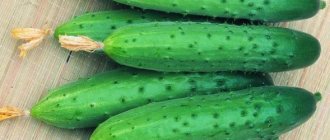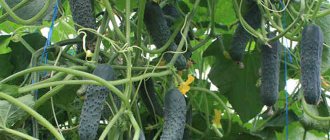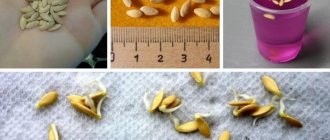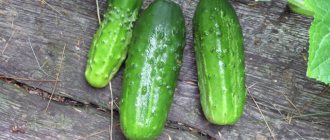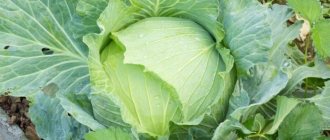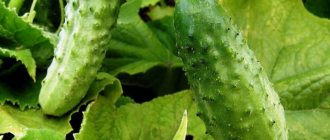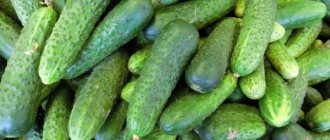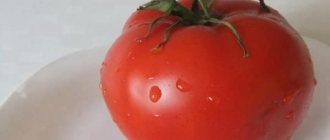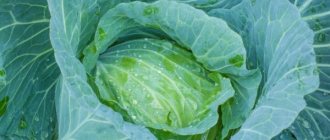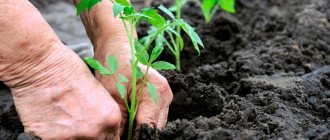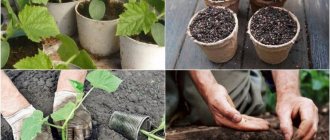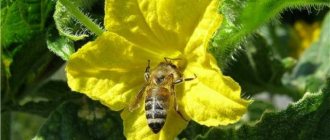The immutable truth of every gardener is that the correctly chosen variety is half the success. Particular care must be taken in selecting plants for open ground with its unpredictability, where temperature changes, heavy rainfall or, conversely, drought often occur. Many breeders are engaged in creating crops that have improved qualities. It’s up to vegetable growers to decide whether the new variety will become popular. Among the cucumber species that have really gained recognition is the Baby. It was announced back in 1991 by the State Scientific Institution Volgograd Experimental Station VNIIR named after. Vavilova RAAS. The author is V.A. Shefatov. The cucumber was included in the State Register of Breeding Achievements of Russia in 1994 with admission to the Lower Volga region (Republic of Kalmykia, Astrakhan, Volgograd and Saratov regions). It is recommended for cultivation in open ground, but if necessary, it can also be grown under film cover.
Taste qualities
Each node produces up to 6 fruits. According to the description of the variety and photo, cucumbers of the Malysh variety grow up to 9-10 cm in length, have a predominantly cylindrical shape with large tubercles.
The skin of the fruit is dark green in color, with light stripes. Young cucumbers of the Malysh variety have a tender skin, while overripe vegetables have a rougher skin.
The fruit pulp is juicy and elastic, there are no voids. The gherkins are not bitter and have a pleasant taste. The average weight is 60-80 g, larger cucumbers reach a weight of 100-120 g.
Description
The plant is indeterminate, medium-sized, climbing. The leaves are green, medium-sized, pentagonal-rounded, with irregularly serrated edges and a wrinkled surface. Leaf length 15 cm, width 12 cm. Flowers are predominantly female. From 3 to 6 ovaries are formed in the leaf axil. The ovary is round-oval, tuberculate, covered with thick dark pubescence. Zelentsy are gherkin-type, short-ellipsoidal in shape, without a neck, with a blunt base. The color is green, with longitudinal blurred stripes from the top to the base. The surface is coarsely tuberculate, with a sparse arrangement of tubercles. Cucumbers reach 8 - 10 cm in length and 3.0 - 3.3 cm in diameter. The mass of cucumbers is 60 - 80 grams. The taste of cucumbers is excellent.
Pros and cons of cucumbers of the Malyshi variety
According to reviews and photos, Malysh cucumbers are a favorite variety among gardeners due to their taste and productivity.
Advantages of the variety:
- precocity;
- simultaneous ripening of cucumbers;
- neat shape of the fruit, which is ideal for canning and pickling;
- compactness of the bush variety;
- high transportability and pleasant appearance: Malysh cucumbers do not lose their taste within 10 days from the moment of collection;
- immunity to downy mildew and cucumber mosaic.
The main disadvantage of the Malysh cucumber is its requirement for watering. Beautiful and even fruits can be obtained only with a timely harvest: thanks to the rapid ripening, it is necessary to remove vegetables from the vine every day. Gardeners consider this feature to be a disadvantage of the Malysh cucumber variety.
Harvesting and storage
The cucumber begins to actively bear fruit in early July. The harvest lasts about a month. At this time, Malysh's greens are collected, according to the description, every 2-3 days. Timely harvesting of fruits stimulates and delays fruiting. It is advisable to do this in the evening, 20 minutes before. before watering.
The cucumber is carefully cut with pruning shears or scissors, leaving the stalk. The harvest of the variety can be stored for about a week - if the unwashed fruits are loosely wrapped in loose cellophane and placed in the refrigerator. The Baby tolerates transportation well, but it is better to avoid long trips.
Optimal growing conditions
The main factor influencing the growth and fruiting of cucumbers of the Malysh variety is the soil. Preparatory work is carried out in the autumn.
It is necessary to decide on the location of the future bed: the soil for cucumbers should be well lit and ventilated. There may be tall plantings nearby: slight shading does not prevent fruiting.
Baby cucumbers grow safely in beds of predecessors such as corn, peas, and tomatoes.
The soil is excessively devastated after garlic, pumpkin or zucchini, so the variety is not planted in their place.
Preparing the soil for cucumbers involves digging it up and applying fertilizer: a bucket of manure per 1 m2. Potassium salt and superphosphate are used as a replacement. The use of ammonium nitrate is mandatory: 15-20 g is enough for 1 m2.
In spring, it is recommended to fence the bed for the variety with sides and prepare trellises for formation.
Important! Malysh cucumbers grow well on loamy and sandy soils.
Diseases and parasites
The baby, according to the description, has excellent immunity to most common diseases. The only thing that a cucumber can suffer from is various types of rot and parasites eating the foliage. Most often this happens in greenhouse conditions - therefore, special attention should be paid to the pre-planting treatment of the walls of the greenhouse where the cucumber will grow with antibacterial drugs, and also to provide the sprouts with good ventilation.
Root rot
Occurs when there is excess moisture and insufficient oxygen access to the roots. The main signs are wilting of foliage, yellowing and cracking of roots. Treat root rot on Malysh with a solution of chalk and copper sulfate. To do this, you need to discard the soil from the top of the root system of the variety and spray it with the above-mentioned product. In this case, the entire cucumber bed must be sprayed with a manganese solution. The best prevention against root rot is regular loosening of the soil around the bushes, as well as deep (20 cm) digging of row spacing.
Gray rot
It affects cucumbers in greenhouses or at high air humidity. Its appearance is provoked by the “greenhouse effect” - heat and humidity. Rot manifests itself as shapeless, weeping spots with a grayish coating on the leaves of the variety, spreading to the stems and fruits. Infected shoots of the Baby should be cut off by treating the cut with lime or chalk and copper powder. If it doesn’t help, use a weak solution of Bordeaux mixture. Plantings must be treated with a solution of zinc sulfate.
Spider mite
This little pest attaches itself to the Baby's leaf on the reverse side and sucks out the juices. The cucumber becomes lethargic, turns yellow and dries out, and thin sticky cobwebs appear on the foliage. The attack of the parasite is combated by treating with a medium concentration soap solution. Phytosailus is planted around Malysh’s beds, which repels ticks. To avoid the appearance of this pest in the beds, they are weeded clean every 5-6 days and the plantings are not allowed to thicken. The areas where the tick was noticed are carefully and deeply dug up in the fall - 40-50 cm.
Growing cucumber variety Malysh
It is preferable to cultivate the variety in open ground. Thanks to its compact size, the garden bed can accommodate a larger number of Malysh cucumber bushes, which saves space on the site.
The growing methods used are direct planting in the ground or the seedling method.
Direct planting in open ground
Before purchasing cucumber seeds, pay attention to their shelf life: planting material harvested more than 2-5 years ago has the maximum germination rate.
To prepare the raw materials for planting, they are prepared: several pieces are soaked in warm water for a day, after which they are transferred to a damp cloth and transferred to a warm place.
Sprouted seeds of cucumbers of the Malysh variety are suitable for further planting, the rest must be disposed of.
After identifying viable samples, they are treated against diseases and pests in the following ways:
- For 2-3 days, place the planting material in a solution of potassium permanganate. It should be a faint pink shade: exceeding the concentration will lead to the death of the sprout.
- Several aloe leaves are trimmed, wrapped in thick dark paper and transferred to the refrigerator for 14 days. After this, the stems are squeezed out and the resulting juice is diluted in water in a 1:1 ratio.
- The prepared solution is sprayed onto the fabric where the cucumber seeds of the Malysh variety are spread and left for 24 hours, after which they are immediately planted in the ground.
Before planting in the ground, make even rows in the garden bed, up to 2 cm deep, then prepare the holes and spill them with water.
The raw materials are laid out and lightly pressed into the soil, sprinkled with earth on top. Place 3-5 seeds in one hole.
The optimal time for the procedure is the end of May or the beginning of June. Place the raw materials according to the scheme: 40x40 cm.
Important! To protect plants from rodents and ants, black and red pepper are scattered around the garden bed.
Cucumbers of the Malysh variety prefer high humidity, so the crops must be covered with polyethylene film. It is possible to build mini-greenhouses or use arcs from a variety of materials.
This procedure allows not only to create the microclimate that Malysh cucumbers need, but also to protect them from unexpected frosts.
After seed germination, it is important to provide them with access to sun and oxygen, so it is necessary to remove the shelter from the plant the day before.
Caring for cucumbers of the Malysh variety consists of timely actions: the soil is not moistened before germination, and after germination of the seeds, it is necessary to regularly provide the soil with moisture.
In sunny weather, watering is carried out once every 2-3 days, in the morning or evening. It is important to prepare settled warm water: cold interferes with the normal development of the root system in cucumbers.
Growing by seedlings
The optimal time for planting is early April. Before the procedure, the seeds are treated and the soil is prepared. To do this, soil, sawdust, humus and peat are thoroughly mixed in equal proportions. Ash and nitrophoska are added as fertilizers (1-2 spoons per 10 kg of mixture).
The prepared soil is filled into plastic containers, wooden boxes or peat tablets. The use of single containers allows you to grow Baby cucumbers with a strong root system.
Several holes are made in the ground, then planting material is placed in them, spilled with water and taken to the windowsill. After emergence (after 6-8 days), picking is carried out if all the seeds have sprouted.
To prevent damage to the roots, the cucumber must be carried with a lump of earth.
The variety is ready to be transferred to the ground 4-5 weeks after germination, when 5-6 true leaves have appeared. Before the procedure, it is necessary to harden the seedlings. To do this, the containers are taken outside, gradually increasing the time they remain in the sun.
Plant the seedlings vertically, making sure that the roots are not damaged. After the procedure, the Baby cucumbers are thoroughly watered and covered with polyethylene overnight. During the day, the covering material is removed.
Watering and fertilizing
Cucumber is a crop that requires frequent watering. For the procedure, it is recommended to use watering cans or special irrigation systems: a strong flow of water erodes the soil, which leads to exposure of the root system and its premature death.
Drip irrigation of cucumbers does not require a waste of time and effort; you only need to control soil moisture and take into account weather conditions.
The undoubted advantages of this type of irrigation are automation, reliability, and the ability to save water resources.
Important! The procedure for moistening the soil is carried out once a day. In regions with hot climates, it is recommended to water Malysh cucumbers twice a day.
Good fruiting is ensured by timely application of fertilizing, the first of which is carried out before the start of flowering, the following procedures are carried out every decade.
Urea, superphosphate and potassium sulfate are used as fertilizers. To do this, 1 tsp. each substance is dissolved in 10 liters of water and the soil at the roots of the cucumbers is irrigated.
It is possible to use mullein or Humanite (1 tbsp per 10 liters of water). In stores specializing in plants it is possible to purchase complex fertilizers such as Ideal and Fertility.
Formation
Since Baby Cucumbers are of bush type: the length of the shoots does not exceed 40 cm, the pinching procedure is not carried out.
To increase the yield and make the bed tidy, it is possible to tie up vines. If the shoots are not attached, they overlap each other, preventing them from receiving sunlight. Leaf plates covering the soil retain moisture in the ground, but in combination with excessive watering or bad weather conditions contribute to the development of fungal diseases.
Trellis and ropes with crossbars are used as supporting structures. The main thing is not to damage the main stem and provide optimal support.
Landing Features
The baby is planted mostly in open ground, so it is usually cultivated in late spring - early summer. Judging by the description, the cucumber is well adapted to small temperature changes and has excellent germination. Its seeds can germinate even in cool climates.
Landing dates
The variety's seed material for seedlings begins to be applied in late April. In turn, the sprouted cucumber is transplanted into the ground, according to the description, at the very beginning of June - after the last spring frosts have passed. A prerequisite for the Baby is a daytime temperature above 16°, and a nighttime temperature not lower than 14°.
It is advisable to plant a few days after precipitation, while the soil is still saturated with moisture.
Site preparation
Primary preparation in the autumn period consists of cleaning the area for cucumbers, digging and replacing the top layer (20-30 cm), as well as adding chicken manure or other organic fertilizer. In the spring, 5-6 days before planting the variety, the area for the Kid is weeded and disinfected with a solution of copper sulfate or salt, after which ridges with holes are cut into which humus and ash are added. If the last rain has passed long enough, the soil under the Baby is moistened artificially through drip irrigation (6 liters per hole).
Planting seeds
Baby seeds, as described, are planted in separate pots, ideally made of peat. The cucumber is introduced into nutritious soil from a mixture of soil with peat, humus and compost, fertilized with nitrophoska and wood ash. The seeds of the variety are buried 2 cm, watered every day, not forgetting to loosen after each watering. Immediately after emergence, the temperature in the room is maintained at 20°, after 3 days it rises to 23°.
Planting seedlings
Malysha seedlings are transplanted 26-30 days after seeding, when 3 leaves appear on the sprouts of the variety. 5-6 days before transplanting, Malyshcha needs to be hardened by placing the seedlings in the sun - first for 15 minutes, then the time increases by 5 minutes every day. Carry the cucumber carefully, directly in peat containers, so as not to damage the roots. It is advisable to choose a cloudy, but warm and windless day for planting varieties. Immediately after transferring, the sprouts are watered generously. If the nights are still cold, the plantings are covered with film until the morning.
Planting scheme
The compact size of the variety allows you to plant 6-7 bushes per 1 m². The main thing is to make sure that the plants do not block each other’s light. The distance between neighboring Malysh bushes is 30 cm. In this case, the cucumber assumes a row spacing of about 50 cm. As it grows, it is recommended to thin out the plantings where they have grown too densely. The first time after planting, the sprouts are covered with film at night.
Diseases and pests
A common problem with Malysh cucumbers is fungal infection. To prevent the disease, it is necessary to treat the seed and soil. The soil is disinfected by irrigating with the fungicide Redomin-gold, and spilled with a saline or manganese solution.
Diseases dangerous for Baby cucumbers are gray, root or white rot, olive spot. When spots appear on the leaf blades or the plant wilts, it is necessary to treat the plant with fungicidal and antifungal agents. It is recommended to remove the affected plant from the garden if the chances of recovery are low: this will save the remaining plants.
Important! The main way to prevent any diseases is proper care and timely feeding, which helps support the immune system of the Baby cucumber.
Characteristics of the variety
Numerous reviews from gardeners indicate good and stable yields of the baby cucumber variety; up to 2.5 kilograms of fruit can be obtained from each crop. This plant is considered early ripening; its growing season, from the emergence of seedlings to the formation of the first green shoots, is only 45 days.
Due to its early ripening, this variety can be planted twice per season - first in April and then in July.
The variety is zoned in the Lower Volga region, but can be used for cultivation in other nearby areas. The main features of bush cucumbers, including the baby variety, are:
- the possibility of growing in beds in open ground;
- during the growing season, the plant forms two underdeveloped side shoots;
- at the top of the main lash, numerous inflorescences and ovaries are formed;
- early continuous fruiting for two or three weeks;
- convenient care of the crop and quick harvest of fruits thanks to compact bushes;
- the possibility of using greens for a wide variety of purposes (preparing salads, canning and pickling).
The baby cucumber is considered a variety, and not a hybrid, like the sturdy baby cucumber. The seed material completely retains the properties of the mother plant.
This means that the seeds can be collected from ripe fruits and used for re-sowing next year. Better plant germination is achieved by using seed material two or three years old.
Reviews of Malysh cucumbers
Chernova Margarita Stanislavovna, 37 years old, Astrakhan
The Baby cucumber is a favorite in our family due to its productivity. All fruits ripen together, so we use them fresh in salads every day. The culture is unpretentious: timely watering, loosening and feeding are the basics of care. As fertilizers for the variety, preference is given to complex fertilizers, which are used according to the instructions. As a result, this is a rich harvest, where the cucumbers are crispy, without bitterness, and beautifully shaped.
Krapivin Ilya Andreevich, 56 years old, Astrakhan
The plot is small, so cucumbers have always been a problematic crop: they spread in different directions. The Malysh variety pleases with its small size and productivity: 2-3 bushes are enough to feed a family and treat neighbors, pickle them for the winter. The fruits are small, but beautifully shaped, with delicate skin, and ripen at the same time. Collected cucumbers are stored for up to 10 days, and neither the appearance nor the taste changes.
Care
When it comes to cultivation, the Kid is absolutely not capricious. The bushes of the variety practically do not require formation; the cucumber also does not require any special agrotechnical procedures. The main thing is generous watering and regular nutritional feeding. Do not forget about periodically loosening the beds of the variety, especially in wet, rainy weather - in order to prevent the appearance of rot.
Watering
Baby loves water and requires watering more often than most other varieties. Water is applied at the root of the bushes every day, and on especially hot days - twice: in the morning and in the evening - after the sun has already lost activity. Cucumber prefers not intensive drip watering with lukewarm, well-settled water.
Garter and bush formation
The variety in question, based on the description, does not require complex manipulations to form a bush. It forms into one stem, the lateral branches of the Kid practically do not grow. In order for the cucumber to ripen successfully, you only need to tie the bushes to low wooden or metal pegs. There is no need to pinch or pinch the baby; it rarely grows.
Top dressing
Baby, as an early variety, needs high-quality, nutritious fertilizers. Feed the bushes before flowering and then every week. This cucumber loves the following fertilizers most of all:
- A solution of potassium, manure and urea - tsp. of each ingredient for 9 liters. water.
- A solution of urea, superphosphate and mullein - 5 g per 10 liters.
- Sodium and potassium humate - during the period of the beginning of fruiting.
It would also be useful to mulch the rows with hay or peat. All fertilizing of the variety is applied only at the root, without affecting the foliage, in order to avoid burns. 7 days before harvesting, the application of all fertilizing to the cucumber, except natural organic matter, is stopped.
Hilling
This variety requires frequent watering, which is why it may suffer from rotting. To prevent this from happening, the bushes are sprinkled with earth every 3 days. The main thing is that a hard crust does not form around the Baby. The cucumber is covered with earth to a height of slightly more than 1/3 of its height. At the same time, mulch is thrown on top around the bush, trying not to touch it. During the first hilling of the variety - immediately after planting - the bush is sprinkled with a little more than half. This way the cucumber will take root and grow stronger faster.
Caring for the variety after planting
Timely weeding and loosening of the soil contribute to the growing season, so you should regularly remove weeds from the beds . Such proximity can damage the roots of the seedlings and cause the plant to rot. Aeration is an integral part of normal care; lack of oxygen weakens the crop's immune system, making it vulnerable to disease.
Cucumbers love water very much, and the Malysh variety is no exception. It is better to water the bushes with low pressure; a strong stream exposes the roots, causing the plant to dry out. The following types of watering are considered ideal:
- sprinkling;
- drip system.
Drip irrigation is ideal for Malysh cucumbers
The frequency of procedures is once a day, and in the absence of rain, moisturizing is carried out twice.
Varieties with early ripening are characterized by intense vegetation. This explains the need for frequent watering and the introduction of bait. The first portion is administered before the flowering period, subsequent doses are administered every 10 days. A solution is used as food, which is prepared from the following components:
- a bucket of water;
- a teaspoon of urea, potassium sulfate, superphosphate;
- a glass of mullein (porridge-like consistency).
An alternative to mullein is humanite (1 tablespoon per bucket of water). Fertilizers that are also suitable:
Experienced gardeners warn beginners about mistakes that are often made when growing bush cucumbers:
- When 6-7 leaves are formed, the tip on the branch is pinched off to form another branch. In the case of Malysh cucumbers, this procedure is considered unnecessary.
- It is not worth reducing the distance between the holes when planting, as thickening provokes rotting . In addition, the thickets become attractive to pests.
- When growing seedlings, it is necessary to harden the plants 1-2 weeks before transferring them to open ground . Otherwise, at the first wind they will lie down in the beds.
- Irrigation should be carried out under strict soil control. Do not allow water to stagnate in it , otherwise it will lead to rotting of the roots.
- No matter how resistant the variety is to diseases and pests, you should not plant seeds in the same place .
Agricultural technology or proper cultivation
The Malysh F1 variety is grown in two ways:
- Planting seedlings;
- Direct sowing of seeds.
Seeds are planted for seedlings in late April or early May. The seedlings are transferred to unprotected soil in early June, when the soil has warmed up sufficiently. In this case, the average daily temperature should not be lower than +16 degrees Celsius.
Transplanting young plants into garden beds should be done carefully so as not to damage the fragile root system.
At first, it is recommended to cover the seedlings with plastic film or agrofibre at night.
Direct sowing of seeds in beds is carried out after the soil has warmed to +15 degrees. In this case, it is necessary to adhere to the following planting scheme:
- The depth of planting seeds is no more than 3 cm;
- The distance between the holes is 25 cm;
- The interval between rows is 45 cm.
Cucumbers require light, non-acidic soil. The place for planting the Malysh F1 variety should be well ventilated and lit. The following crops are considered ideal predecessors of cucumbers:
- Peas;
- Tomatoes;
- Potato;
- Corn.
It is recommended to prepare a site for planting vegetables in the fall.
The soil should be thoroughly dug up with the simultaneous application of manure or a mixture of superphosphate and potassium salt. In the spring, the site is dug up and ammonium nitrate is introduced into the soil in the beds.
Loamy and sandy loam soil varieties are ideal for growing Baby F1, Korotyshka, and Bush cucumbers.
IMPORTANT: It is not recommended to plant cucumbers after garlic, pumpkin, zucchini and squash.
Wonderful little one
The length of the cucumber stems does not exceed half a meter, the fruits - no more than 10 centimeters. Caring for the crop is very simple, and the ripening time is the shortest. The variety belongs to the category of “young and early”, quickly ripening. The fruits are ready to be picked from the bush a month to a month and a half after the first shoots appear. The cucumber itself has a dark green color and lumpy skin.
The plant has strong immunity. Cucumber successfully resists various diseases - from downy mildew to cucumber mosaic. Cucumber yield is average; up to two kilos of fruit are usually harvested from a bush. The weight of one of them reaches 80–100 grams.
The Malysh variety was bred by breeders from Volgograd.
Pest protection
The hybrid is susceptible to fungal diseases. It is necessary to treat the seeds before planting to avoid their contamination by fungal spores that may sit in the soil. A saline solution or Redomin-gold product is suitable for this purpose.
If you follow simple recommendations for caring for the Malysh variety, this cucumber variety can be planted in different regions of Russia. The devil has many positive characteristics, which gives him an important advantage over other hybrids.
Allergy? For a cucumber?
Are you surprised? And this is understandable.
An allergic reaction to cucumber is almost exotic. This vegetable is hypoallergenic and rarely causes negative allergic reactions.
But that is precisely why, if suddenly a reaction occurs, parents cannot understand for a long time what exactly it is for.
- Sometimes it does occur in children under 2 years of age, so you cannot rule out this possibility in your child. Especially if there are people in the family who are prone to allergies;
- Or, if you give the baby a cucumber too early, when his digestion perceives any new product as a potential “enemy”. In this case, an allergic reaction may also occur.
Here I would like to draw your attention to something else:
Recently, a reaction to cucumber has become more and more common, as parents think, which is actually a protest of the small organism not to the vegetable itself, but to the harmful substances with which it was supplied during the growing process.
Therefore, the issue of choosing the right vegetable is so important.
And, if suddenly negative manifestations appear in the form of a rash, itching, runny nose or other signs of allergy after introducing the child to cucumber, you need to give up the vegetable for 2-3 weeks.
I hope now you know everything about how to introduce cucumber into your baby’s complementary foods and not harm your little one. Accustom him to this wonderful vegetable correctly, and the benefits will be obvious!
- Vegetables for first feeding
- WHO complementary feeding table
- How to feed a child correctly?
Preparing the soil in the garden bed
Cucumbers are grown in a regular or high bed, the latter warms up faster in the spring.
Loamy or sandy loam soils with a neutral acid reaction are ideal for growing cucumbers. The best predecessors of this crop are legumes, corn, tomatoes or potatoes. It is better not to plant the plant in areas where zucchini, garlic or melons grew last year.
In the fall, when digging the beds, humus or compost is added to the soil; manure can also be used. From mineral fertilizers, add superphosphate 40 grams per square meter and potassium sulfate 25 grams per unit area. In the spring, before sowing, the soil is enriched with ammonium nitrate at the rate of 20 grams of the substance per square meter.
Advantages and disadvantages
The “Malysh” variety has the following advantages:
- Good germination;
- Precocity;
- The versatility of using the harvested crop;
- Excellent taste characteristics;
- Good transportability, while maintaining its presentation;
- Compactness;
- Long shelf life;
- Good resistance to diseases and pests
- Stable yield;
- Shade tolerance.
The disadvantages of this variety include:
- Intensive fruiting. It is necessary to harvest the crop every day, otherwise the fruits will become overripe;
- Compliance with the watering regime, since the variety is moisture-loving.
